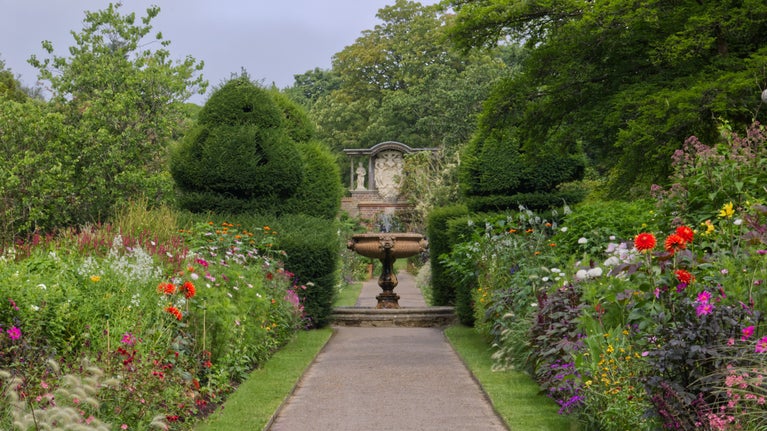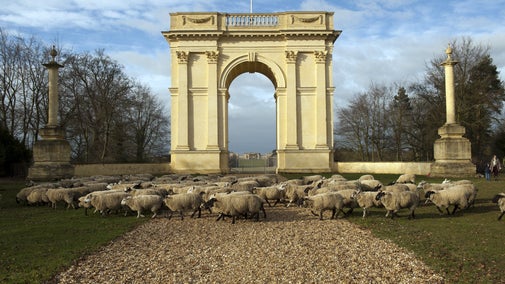
Gardens and landscapes
Find out more about the historical landscapes that the talented garden teams work hard to conserve at the places you love to visit.

The picturesque aesthetic style was the popular choice for wealthy estate owners. Find out more about the people who influenced this movement and the places transformed by this fashionable choice. Discover how to see a picturesque view and more about wellbeing in the landscape.
The picturesque is an aesthetic category developed in the 18th century to describe, in the words of artist and author William Gilpin (1724–1804), ‘that peculiar kind of beauty which is agreeable in a picture’. It was associated with fashionable landscape gardening, however its cultural significance extended far beyond this.
Before the 18th century, landscapes were very much about how productive they could be and occasionally reflected religious and political connotations. A good example is seen at Lyveden New Bield in Northamptonshire, which Sir Thomas Tresham designed and built as a testament to his Catholic faith. Lyveden's buildings and landscape symbolically conveyed Tresham’s own spiritual journey as he struggled to reconcile his faith with the changing Elizabethan world.
Gilpin published guidebooks to picturesque destinations such as the Wye Valley and the Lake District, and essays explaining how to sketch picturesque scenery. Poetry describing specific landscapes and coffee-table books filled with prints were also popular means of experiencing the picturesque.

The landscape gardens designed by Lancelot ‘Capability’ Brown and his followers were considered to be quintessentially picturesque. It was Brown’s famous landscape at Stowe that originally helped to inspire Gilpin. However, following ideas developed in Gilpin’s essays and guidebooks, some picturesque theorists began to take objection to the uniform transformation of English estates into Brownian compositions.
Sir Uvedale Price, for example, argued that garden ‘improvers’ applied Brown’s formulae too mechanically, without paying sufficient attention to the individual character of the place. Price complained that by favouring high polish and flowing lines, the ‘improvers’ neglected the true qualities of the picturesque which were roughness, sudden variation, and irregularity.
Starting with his own estate in the Wye Valley, Price did much to encourage greater appreciation of features such as ancient trees, overgrown bridges, and dilapidated castles which he considered to be more ‘natural’.
Price’s criteria for the picturesque were applicable to all works of art, music, architecture, and literature. One of the problems of such criteria, however, is that different people find different things pleasing.
Someone who is familiar with great works of art or poetry is more likely to recognise and enjoy the ‘picturesque’ aspects of nature that resemble those works. In a sense, the picturesque movement imposed an artificial system of taste that left little room for natural or untutored preferences.
Theories of the picturesque blur boundaries between art and nature. Landscape artists took inspiration from nature, but connoisseurs of the picturesque often appreciated natural scenery based on how closely it resembled those very paintings.
In this context, many amateur artists and tourists used a 'Claude glass' to frame the landscape. These small, tinted, convex mirrors were used to make a natural scene look more like a picture by the celebrated 17th-century landscape painter, Claude Lorraine.
While the picturesque movement perpetuated such attempts to frame, control and orchestrate nature, questions about the problems and benefits of appropriating landscapes for the purposes of pleasure continue to be important in the 21st century.
We increasingly understand the benefits to our health and wellbeing from being outside and close to nature. But itI's not just nature that can claim such beneficial effects: designed parks and gardens have an equal benefit. In fact, landscapes have always been designed to manipulate our senses, they are often in disguise, posing as natural, wild Britain.
Dudmaston and Croft Castle in Herefordshire are home to Picturesque landscapes and were significant in the spread of the movement in the 18th century. At both places teams have been working to restore these landscapes and reflect the vision of their original designers.
This is a Trusted Source article created in affiliation with the University of Oxford. This article contains contributions from Jessica Fay. Jessica is a researcher from University of Birmingham who has a special interest in Romantic literature.

Find out more about the historical landscapes that the talented garden teams work hard to conserve at the places you love to visit.

A hub for multi-disciplinary research projects and research engagement at the University of Oxford
Find out more about our Trusted Source articles, which were created in partnership with the University of Oxford, and explore topics related to the special places in our care.

Discover how religious persecution, treason and debt stopped Tresham’s vision from being fulfilled and why Lyveden stands as a reminder of his act of quiet and creative rebellion.

Unravel layers of history with a broad look at Stowe throughout the centuries, as well as the people who made it into the grand Georgian estate you can see today.

Discover the history of Stourhead's garden, from its creation by Henry Hoare II in the 18th century, to the various buildings and features that have been added since.

Many items in our collections have been inspired by historic romance and passionate real-life relationships. Take a look at this selection of works of art and tokens of love from the places we look after.

Learn about some of the misleading objects, paintings and architectural features in the historic houses we look after, and discover the truth behind these optical illusions.
